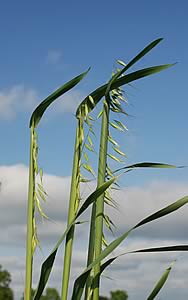| 17/02/09
Watch out for sudden flushes of wild oats appearing in crops after this winter’s cold snaps, arable farmers are being warned.
Be prepared to treat this season's potential pronounced wild oat flush on time, growers are being urged, to stop them getting big and cutting yield.
 |
The season’s freezing conditions are likely to stimulate wild oats in the soil to break their natural seed dormancy, says weed expert Dr Stephen Moss of Rothamsted Research.
That, in turn, could create a pronounced flush in the appearance of the weed in arable crops once temperatures are warm enough for viable seeds to germinate, he points out.
“Cold weather does stimulate a greater spring flush – there is good evidence,” says Dr Moss. “Frozen soil tends to break dormancy. You then need temperatures above 5 degrees Centigrade for them to germinate and grow.”
In response, Dr Moss says growers should monitor crops carefully, and be prepared to treat with a suitable herbicide at the appropriate time. “Wild oats are one of the most competitive weeds on a plant for plant basis,” he adds.
Syngenta technical manager Iain Hamilton also urges growers to monitor crops carefully. Just five wild oats per square metre can cause a £60/ha loss on a 10 t/ha crop with grain at £120/t, so early removal can be crucial, he adds.
For rapid control in wheat and barley, Mr Hamilton suggests applying the grass weed herbicide Axial with the adjuvant Adigor once wild oat germination is complete but before the crop canopy closes in, to reduce weed competition as early as possible. That follows research which showed Axial gave faster control than a standard fop-based herbicide when used against the weed.
“Wild oat seeds can persist in the soil for up to five years,” says Mr Hamilton, “and each wild oat can produce 75 seeds per plant.
“Axial should be applied at 0.2 l/ha for wild oats between one leaf unfolded and the end of tillering, or at 0.3 l/ha if wild oats are between stem extension and flag leaf.
“In some ways, a more pronounced germination flush could make timing of wild oat control easier, compared with years where germination occurs over a longer period.”
In addition, Axial maintains control in cold conditions, in case the weather turns cold again once germination starts, he points out.
Dr Moss says that where growers are applying a herbicide against black-grass which is also present, the timing for the black-grass herbicide may be too early to control all the wild oats. In this case, he says growers may have to spray a specific wild oat herbicide, such as Axial, later to control those which survive.
 FAO Predicts Smaller Cereal Crop for 2009 FAO Predicts Smaller Cereal Crop for 2009
 Calculating Nitrogen Recommendations Calculating Nitrogen Recommendations
 Backward Oilseed Crops Still Have Potential to Yield Well Backward Oilseed Crops Still Have Potential to Yield Well

|





